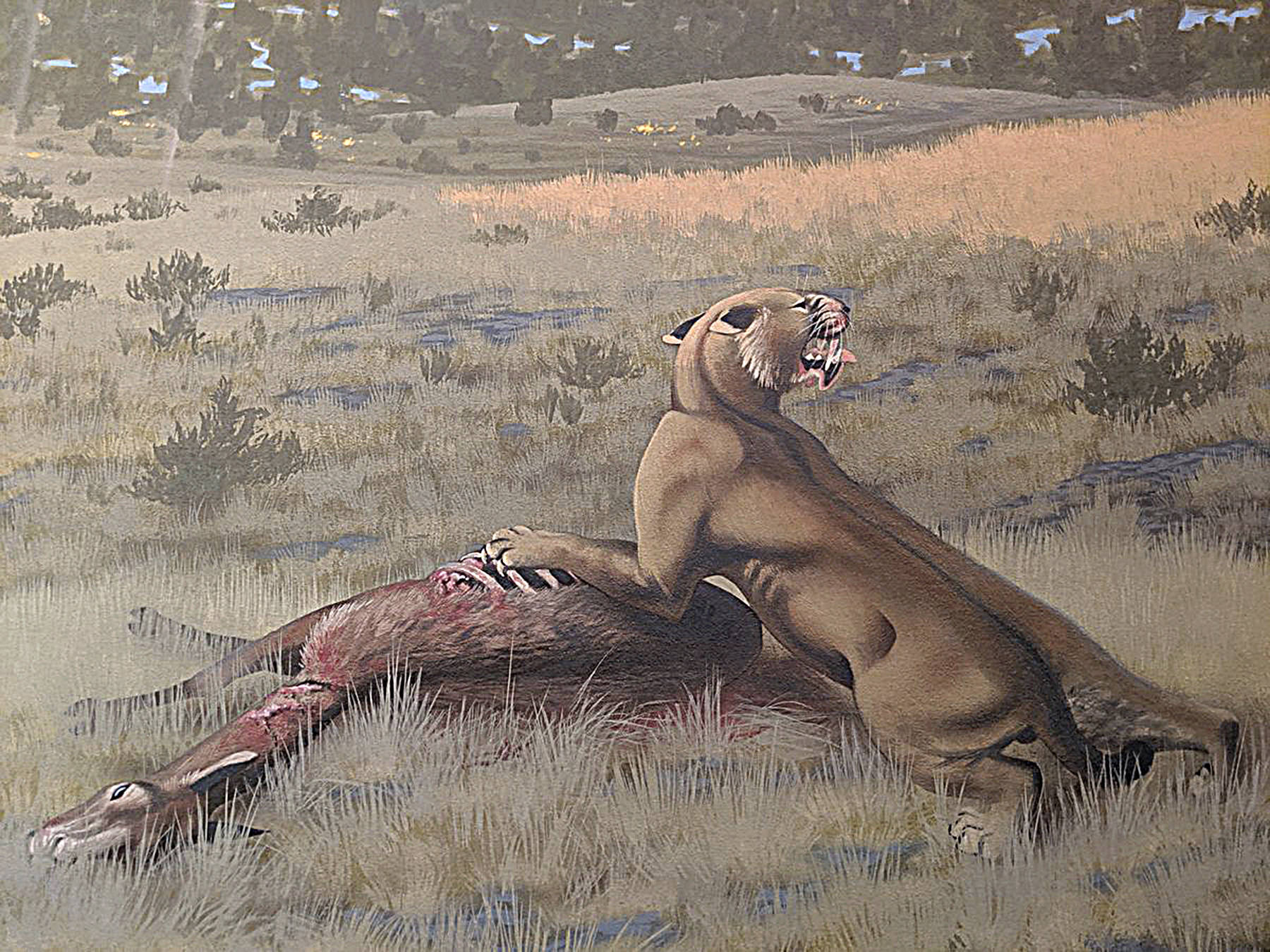Greg Mason
The Spokesman-Review
Imagine a cat. Now imagine that cat weighs as much as 900 pounds and eats things the size of a rhinoceros.
Certainly a far cry from Garfield, this newly discovered species of saber-toothed cat roamed the Inland Northwest and other parts of North America 5 million to 9 million years ago, according to research partly led by John Orcutt, an assistant professor of biology at Gonzaga University.
The cat, identified as Machairodus lahayishupup (pronounced mah-CHI-rho-duss lah-HIGH-ees-hoop-oop), is estimated to have weighed around 600 pounds on average and could have killed prey that weighed upward of 4,500 pounds. The findings were published earlier this month in the Journal of Mammalian Evolution.
Machairodus is a genus of large saber-toothed cats that lived in places including Asia, Europe and North America. For the species name, Orcutt said he and Jonathan Calede, co-author on the research, were keen to work with the Confederated Tribes of the Umatilla Indian Reservation to recognize how a bone specimen analyzed with the research was found on tribal land.
Accordingly, lahayishupup is a compound of two words in old Cayuse language: “lahayis” means “ancient,” while “hupup” means “wild cat.”
“This thing is massive,” Orcutt said. “Because we only know it from bits and pieces, it’s a little hard to put an exact size on it, but it’s up there with the largest cats that ever lived. It’s certainly in the same size range and probably a little bit bigger than the very largest tigers on record today as the largest living cat. It’s in the running for the largest cat to ever live.”
Researchers believe the new species is an ancient relative of the Smilodon, a saber-tooth cat that went extinct about 10,000 years ago. Smilodon fossils have been found in the La Brea Tar Pits in California.
The new cat, like the Smilodon, is a part of a subfamily that is mostly extinct, separate from felines such as lions, tigers and panthers, said Orcutt, an expert in paleobiology. The largest of the humerus fossils analyzed through the research was more than 18 inches long and 1.7 inches in diameter, according to The Ohio State University.
By comparison, the average modern adult male lion’s humerus is about 13 inches long.
“There’s a very interesting pattern of either repeated independent evolution on every continent of this giant body size in what remains a pretty hyperspecialized way of hunting, or we have this ancestral giant saber-toothed cat that dispersed to all of those continents,” Calede, an assistant professor of evolution, ecology and organismal biology at The Ohio State University, said in a statement. “It’s an interesting paleontological question.”
Back around 2007 or so, Orcutt was a University of Oregon graduate student working for the university’s Museum of Natural and Cultural History.
He was inventorying fossils in the museum’s vault when he saw part of a “giant” arm bone that the collection identified as a cat bone. Orcutt was skeptical at first.
“We ran through the possibility of it being a rhino, which is very common from that period of time in eastern Oregon. A bear; the first true bears in North America are showing up around that time,” he said. “But it turns out when you started comparing these things to other specimens, it’s definitely a cat. It’s just a huge cat.”
While the find stuck with Orcutt, responsibilities as a graduate student — and later as a professor — left any significant research on the back burner.
He came upon more pieces in the years to follow, however. Key among those was a lower jaw at the Idaho Museum of Natural History; Orcutt said teeth are historically important for identifying most mammals.
To date, researchers have found and linked seven bone specimens with the cat that are now at four museums in Oregon, Idaho, California and Texas.
That includes an arm bone Orcutt and three Gonzaga undergraduate students discovered in 2017. The team found the bone on a federal site just outside of Pendleton during their first day in the field, Orcutt said.
“I would’ve been happy with any fossil on that first day,” he said. “The fact that the first thing we found was this cat that I had sort of been thinking about for years was even better.”
Orcutt said he first connected with Calede, who was his office mate in graduate school, approximately four years ago about the discoveries.
It wasn’t until the COVID-19 pandemic that the two had time for a proper analysis. Calede was instrumental in that, Orcutt said, using software to compare two-dimensional models of Machairodus lahayishupup bone specimens with those of other species.
“Their unique shape and size told us they were also very different from everything that is already known,” Calede said in a statement. “In other words, these bones belong to one species and that species is a new species.”
With the research published, Orcutt said researchers hope to return to eastern Oregon this summer for more fieldwork with some key questions in mind.
In particular, how did these cats interact with their environment? And why did they get so big?
“I have no idea what we’ll find, but I’m sure that whatever we do find will inspire new questions that I can’t even conceptualize yet,” Orcutt said. “The fun thing about paleontology is you never know what you’re going to find, and you never know what questions that’s going to raise.”



